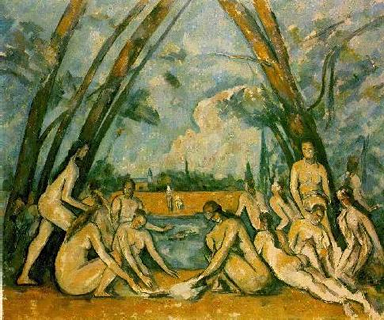The last of this year’s summer pictures is Paul Cezanne’s Bathers, which is to be found in the National Gallery in London. Worked and reworked for many years, the painting was finally completed in 1906, just months before Cezanne’s death. One of three monumental depictions of bathers undertaken by the artist in his last years, this particular canvas, a mysterious vision of humanity in communion with nature, was first recorded by the painter Jules Borely after a visit to Cezanne in Aix-en-Provence in 1902. “A troop of female nudes with white bodies, on a ground of lunar blues”, was his terse description. Years later, the English sculptor Henry Moore recalled his own first encounter with this dauntingly strange masterpiece of Cezanne’s last years as one of the ten most visually intense experiences of his life.
Cezanne turned to the theme of nudes bathing by a riverbank after many years of painting still lifes, portraits and landscapes in his native Provence. The subject may have reminded him of the summers of his carefree youth, when he and his childhood friends Baptistin Baille and the writer Emile Zola would walk out into the countryside around Aix to cool off in the waters of the Arc river. In his semi-autobiographical novel, L’Oeuvre, Zola later recalled how the group would “spend whole days there, stark naked, drying themselves on the burning sand, and then replunging into the river, living there as it were… They had even planned an encampment on the banks where they were to live like savages, happy with constant bathing…”
Cezanne was also drawn to this Arcadian theme by his admiration for the great multi-figured religious and mythological pictures of the past, but above all perhaps by the desire to find a subject that might sum up in some...


